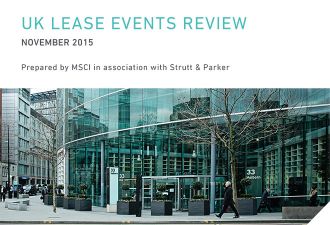
Now in its 17th year, we are proud to have sponsored the lease events element of this report since its inception. In recent years we have joined forces with the BPF and incorporated information on new leases, allowing us to present the full spectrum of UK tenant behaviour in one report.

Now in its 17th year, we are proud to have sponsored the lease events element of this report since its inception. In recent years we have joined forces with the BPF and incorporated information on new leases, allowing us to present the full spectrum of UK tenant behaviour in one report.
In its entirety, the report gives us the ability to consider outcomes when lease events occur (be they expiries, tenant break options, or tenant defaults), and the likely terms of new leases in the aftermath of those lease events. Thus giving investors a strong insight into the future cash flows from their property investments. The ability to drill down to different sectors and geographies allows investors to take this analysis further, looking in detail at the variable lease event outcomes and new lease lengths of the various segments.
Over the long-term the UK property market has transitioned from 20-year plus leases to an average lease length of just over seven years in the first half of 2015. Although we have seen a recovery from the depths of the market in 2009, where the average new lease was for just six years, we continue to consider the shift to shorter leases a ‘structural change’ and don’t expect new lease lengths to trends upwards to any significant degree as occupier demand grows.
Indeed, in the past year we have seen serviced office operators catapulted into the limelight as they take increasing amounts of space, often being the first to prelet major office developments in London.
Whilst they themselves are signing leases of up to 20-years, this of course disguises the fact that the underlying demand for their services is from occupiers taking on much shorter commitments – something not picked up in the data. On the retail side, major landlords are increasingly looking to pop-up retail to not just fill empty space, but actually act as a key plank of their footfall strategy – with today’s consumer always looking for a new and unique experience.
Looking forward, with yields at historically low levels, particularly in prime segments, and the consensus suggesting a turning in the interest rate cycle sometime next year, investors’ ability to maintain and grow property income will be key to driving returns. The rental growth outlook certainly appears strong for the next five years, and not just in central London. It will be those investors that take a realistic view on lease events, and plan appropriately for their outcome and aftermath, with a focus on the underlying drivers of demand, who will succeed as the property cycle moves into its next phase.I would like to thank MSCI for continuing to produce the excellent analysis on both new and existing lease activity, which is fundamental in underpinning property as a mainstream asset class.
View the full Lease Events Review November 2015.
